
The Gallery plans to bring to ArtBo 2022 a mixed proposal showing different artistic media. We hope that this proposal will enrich the experience of the attending public without leaving aside the technical and conceptual rigor that we usually present at ArtBO.
Contemporary art gallery with a project that promotes and supports young colombian artists. Established in 2009, it is located in the San Felipe neighborhood. In addition to its regular programming, it has a program of guests artists, which includes artists from other generations.
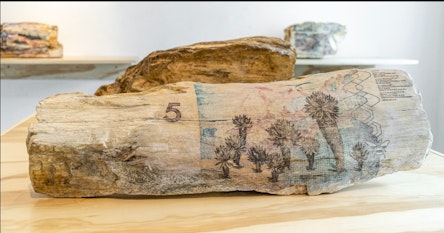
Exchange value suggests the reflection on the landscapes immortalized in the banknotes as an index of a controlled and domesticated nature; of a paradise banknotes as an index of controlled and domesticated nature; of a perennial paradise, resistant to perennial and resistant to the passage of time through persistence, effort and the action of man. and the action of man. Landscape constitutes one of the axes of inquiry in the work of David Guarnizo, through the visual, approaching philosophical problems related to space, time and other concepts that time and other concepts that situate the presence, the look and the human action on space. on space. Since 2014, some of his projects have been based on the semantic reconstruction of notions such as the semantic reconstruction of notions such as limit, border, territory and place, reflecting on the horizon as a line that marks territorial limits, permanent and visible, yet visible but ungraspable territorial limits. In his works, the gaze exerts an act of delimitation on the territory to the point of delimitation on the territory until it becomes a landscape, and the artist-walker's journey emphasizes the dividing lines that the artist-walker emphasizes the dividing lines that remain hidden behind a building or a geographical geographical accident. Guarnizo also reflects on the horizon as the limit of an observer's visual field over the surrounding territory. However, he also studies the word 'horizon' from the metaphoric and poetic value that defines it as the set of anticipations, expectations and set of anticipations, expectations and dreams that guide the subject's vital drift. Following this connotation, he proposes that when a person approaches the traced horizon, he/she does not find anything different from what has inhabited and oriented his will from the beginning of the journey. The same thing happens plastically when the artist moves through a vast territory as he moves towards the horizon. as he moves towards the horizon; as he moves away, his figure merges with the landscape, with that line of destiny. Stripped of all instrumental intention, walking is observed as a way of inhabiting the world. The media through which he materializes these reflections and questions are drawing, video, photography, sculpture, performance, among others.
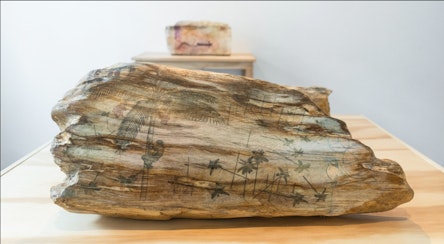
Exchange value suggests the reflection on the landscapes immortalized in the banknotes as an index of a controlled and domesticated nature; of a paradise banknotes as an index of controlled and domesticated nature; of a perennial paradise, resistant to perennial and resistant to the passage of time through persistence, effort and the action of man. and the action of man. Landscape constitutes one of the axes of inquiry in the work of David Guarnizo, through the visual, approaching philosophical problems related to space, time and other concepts that time and other concepts that situate the presence, the look and the human action on space. on space. Since 2014, some of his projects have been based on the semantic reconstruction of notions such as the semantic reconstruction of notions such as limit, border, territory and place, reflecting on the horizon as a line that marks territorial limits, permanent and visible, yet visible but ungraspable territorial limits. In his works, the gaze exerts an act of delimitation on the territory to the point of delimitation on the territory until it becomes a landscape, and the artist-walker's journey emphasizes the dividing lines that the artist-walker emphasizes the dividing lines that remain hidden behind a building or a geographical geographical accident. Guarnizo also reflects on the horizon as the limit of an observer's visual field over the surrounding territory. However, he also studies the word 'horizon' from the metaphoric and poetic value that defines it as the set of anticipations, expectations and set of anticipations, expectations and dreams that guide the subject's vital drift. Following this connotation, he proposes that when a person approaches the traced horizon, he/she does not find anything different from what has inhabited and oriented his will from the beginning of the journey. The same thing happens plastically when the artist moves through a vast territory as he moves towards the horizon. as he moves towards the horizon; as he moves away, his figure merges with the landscape, with that line of destiny. Stripped of all instrumental intention, walking is observed as a way of inhabiting the world. The media through which he materializes these reflections and questions are drawing, video, photography, sculpture, performance, among others.
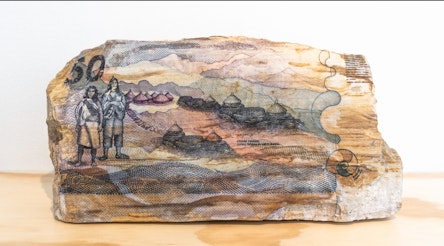
Exchange value suggests the reflection on the landscapes immortalized in the banknotes as an index of a controlled and domesticated nature; of a paradise banknotes as an index of controlled and domesticated nature; of a perennial paradise, resistant to perennial and resistant to the passage of time through persistence, effort and the action of man. and the action of man. Landscape constitutes one of the axes of inquiry in the work of David Guarnizo, through the visual, approaching philosophical problems related to space, time and other concepts that time and other concepts that situate the presence, the look and the human action on space. on space. Since 2014, some of his projects have been based on the semantic reconstruction of notions such as the semantic reconstruction of notions such as limit, border, territory and place, reflecting on the horizon as a line that marks territorial limits, permanent and visible, yet visible but ungraspable territorial limits. In his works, the gaze exerts an act of delimitation on the territory to the point of delimitation on the territory until it becomes a landscape, and the artist-walker's journey emphasizes the dividing lines that the artist-walker emphasizes the dividing lines that remain hidden behind a building or a geographical geographical accident. Guarnizo also reflects on the horizon as the limit of an observer's visual field over the surrounding territory. However, he also studies the word 'horizon' from the metaphoric and poetic value that defines it as the set of anticipations, expectations and set of anticipations, expectations and dreams that guide the subject's vital drift. Following this connotation, he proposes that when a person approaches the traced horizon, he/she does not find anything different from what has inhabited and oriented his will from the beginning of the journey. The same thing happens plastically when the artist moves through a vast territory as he moves towards the horizon. as he moves towards the horizon; as he moves away, his figure merges with the landscape, with that line of destiny. Stripped of all instrumental intention, walking is observed as a way of inhabiting the world. The media through which he materializes these reflections and questions are drawing, video, photography, sculpture, performance, among others.

Art is a creative process that brings together: historical knowledge, technical knowledge, reflection on the world and a great perceptive capacity. In this interaction between knowledge, disciplines and experiences, it is fundamental the link between academic training and sensibility, between the knowledge that preexists or is continually transformed, and the feelings that make us human. For me, the museographic space is a place where the relations between forms and planes, materials and tools, works and people. For this reason, for some time now I have been exploring concepts based on several concerns that arise from this. I have been an artist or an assembler in this context, builder of my own ideas or of the designs of other artists or curators, who seek to create new situations or transfigure the "white cube". In consonance with all this, I want to give another symbolic dimension to the facts, by proposing openings for the interpretations of instruments, materials and objects, which are often minimized before the transcendence of the "plastic work".

Art is a creative process that brings together: historical knowledge, technical knowledge, reflection on the world and a great perceptive capacity. In this interaction between knowledge, disciplines and experiences, it is fundamental the link between academic training and sensibility, between the knowledge that preexists or is continually transformed, and the feelings that make us human. For me, the museographic space is a place where the relations between forms and planes, materials and tools, works and people. For this reason, for some time now I have been exploring concepts based on several concerns that arise from this. I have been an artist or an assembler in this context, builder of my own ideas or of the designs of other artists or curators, who seek to create new situations or transfigure the "white cube". In consonance with all this, I want to give another symbolic dimension to the facts, by proposing openings for the interpretations of instruments, materials and objects, which are often minimized before the transcendence of the "plastic work".
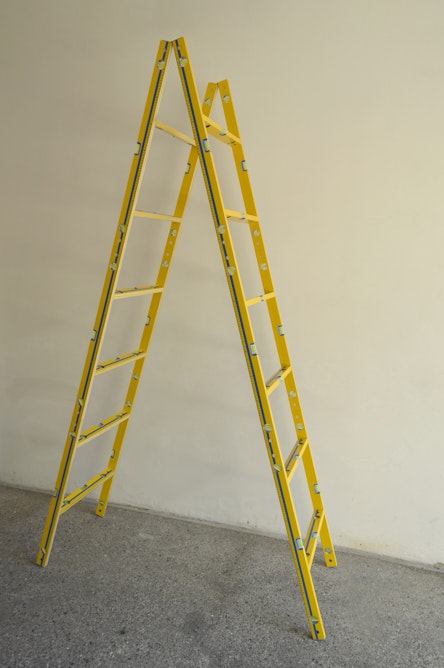
Art is a creative process that brings together: historical knowledge, technical knowledge, reflection on the world and a great perceptive capacity. In this interaction between knowledge, disciplines and experiences, it is fundamental the link between academic training and sensibility, between the knowledge that preexists or is continually transformed, and the feelings that make us human. For me, the museographic space is a place where the relations between forms and planes, materials and tools, works and people. For this reason, for some time now I have been exploring concepts based on several concerns that arise from this. I have been an artist or an assembler in this context, builder of my own ideas or of the designs of other artists or curators, who seek to create new situations or transfigure the "white cube". In consonance with all this, I want to give another symbolic dimension to the facts, by proposing openings for the interpretations of instruments, materials and objects, which are often minimized before the transcendence of the "plastic work".
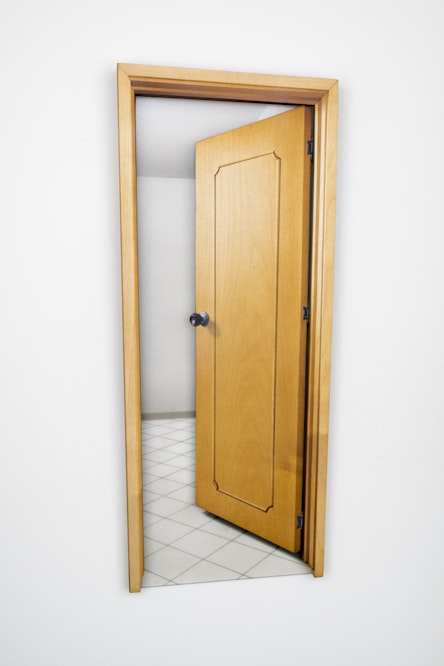
A paradoxical furniture. In this series of works called A Paradoxical Furniture I explore concepts such as perspective, optical illusions, visual paradoxes, optical distortions in photography and other aspects and resources of visual perception. The works included in this series are images of furniture and everyday objects such as doors, boxes, paintings and crates that are drawn and represented in perspective with the same parts or the same materials that make them up. In some of them, as in the work "It's not what you are thinking" the crates were modified, cut and painted so that when reassembled again produce the sensation of depth and three-dimensionality on a two-dimensional surface. Thus, the originally three-dimensional object was transformed into a representation of itself, creating an optical illusion of spatial depth. By bringing together in these representations of everyday objects a three-dimensional appearance achieved through painting with the materials that make up these objects, I seek to invoke the memory and experiences that we have all had with objects, materials and spaces and generate a reflection on the meanings that we have culturally and individually assigned to them. In this way, the dimensions of these representations, as happens in the distortion generated by perspective, become smaller as they are farther away, so the size of the works also speaks of distance, not only spatial but also emotional or affective distance. Likewise, the technique in which these works are elaborated seeks to create a dialogue between the painting, applied to different surfaces, the sculptural forms and the illusion of depth that everyday objects have given by the changes of color, light and shapes. This dialogue generated by painting applied to different surfaces and materials has given rise to the exploration of different techniques such as airbrushing, painting with wood lacquer and acrylic paint, applied in such a way that they seek to achieve these optical illusions and at the same time preserve the appearance and texture of the objects. and at the same time preserve the appearance and texture of the different materials and elements that make up the objects in the objects in everyday experience. Translated with www.DeepL.com/Translator (free version)
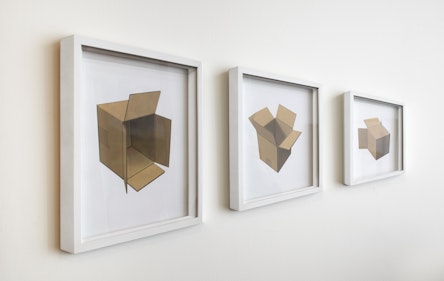
A paradoxical furniture. In this series of works called A Paradoxical Furniture I explore concepts such as perspective, optical illusions, visual paradoxes, optical distortions in photography and other aspects and resources of visual perception. The works included in this series are images of furniture and everyday objects such as doors, boxes, paintings and crates that are drawn and represented in perspective with the same parts or the same materials that make them up. In some of them, as in the work "It's not what you are thinking" the crates were modified, cut and painted so that when reassembled again produce the sensation of depth and three-dimensionality on a two-dimensional surface. Thus, the originally three-dimensional object was transformed into a representation of itself, creating an optical illusion of spatial depth. By bringing together in these representations of everyday objects a three-dimensional appearance achieved through painting with the materials that make up these objects, I seek to invoke the memory and experiences that we have all had with objects, materials and spaces and generate a reflection on the meanings that we have culturally and individually assigned to them. In this way, the dimensions of these representations, as happens in the distortion generated by perspective, become smaller as they are farther away, so the size of the works also speaks of distance, not only spatial but also emotional or affective distance. Likewise, the technique in which these works are elaborated seeks to create a dialogue between the painting, applied to different surfaces, the sculptural forms and the illusion of depth that everyday objects have given by the changes of color, light and shapes. This dialogue generated by painting applied to different surfaces and materials has given rise to the exploration of different techniques such as airbrushing, painting with wood lacquer and acrylic paint, applied in such a way that they seek to achieve these optical illusions and at the same time preserve the appearance and texture of the objects. and at the same time preserve the appearance and texture of the different materials and elements that make up the objects in the objects in everyday experience. Translated with www.DeepL.com/Translator (free version)
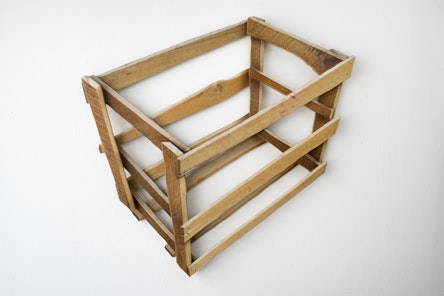
A paradoxical furniture. In this series of works called A Paradoxical Furniture I explore concepts such as perspective, optical illusions, visual paradoxes, optical distortions in photography and other aspects and resources of visual perception. The works included in this series are images of furniture and everyday objects such as doors, boxes, paintings and crates that are drawn and represented in perspective with the same parts or the same materials that make them up. In some of them, as in the work "It's not what you are thinking" the crates were modified, cut and painted so that when reassembled again produce the sensation of depth and three-dimensionality on a two-dimensional surface. Thus, the originally three-dimensional object was transformed into a representation of itself, creating an optical illusion of spatial depth. By bringing together in these representations of everyday objects a three-dimensional appearance achieved through painting with the materials that make up these objects, I seek to invoke the memory and experiences that we have all had with objects, materials and spaces and generate a reflection on the meanings that we have culturally and individually assigned to them. In this way, the dimensions of these representations, as happens in the distortion generated by perspective, become smaller as they are farther away, so the size of the works also speaks of distance, not only spatial but also emotional or affective distance. Likewise, the technique in which these works are elaborated seeks to create a dialogue between the painting, applied to different surfaces, the sculptural forms and the illusion of depth that everyday objects have given by the changes of color, light and shapes. This dialogue generated by painting applied to different surfaces and materials has given rise to the exploration of different techniques such as airbrushing, painting with wood lacquer and acrylic paint, applied in such a way that they seek to achieve these optical illusions and at the same time preserve the appearance and texture of the objects. and at the same time preserve the appearance and texture of the different materials and elements that make up the objects in the objects in everyday experience. Translated with www.DeepL.com/Translator (free version)
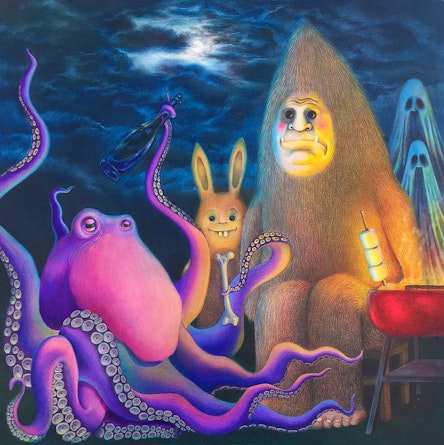
Frupper Valley, the empiricist rabbit. Vertigo; being suspended and the fall. Frupper's Valley was imagined as a metaphorical, physical and metaphysical place that refers to painting and the mind. To Painting (with a capital P), posing it as a place beyond the thing where it happens what one prefers to each one's taste. And to the mind, the place where our thoughts lodge and conjectures wander; the place where variable mental states are experienced and where we manage to construct sense of everything, including imagery. At the intersection of both places converges a concept that concerns the field of Art and from which we cannot escape; in that space lies the seed of the idea of conceptual art that dates back to the Renaissance: "Art - Leonardo Da Vinci affirmed - is a mental thing". That is to say, it exists in the mind, or, in other words, it is the same thing: it is a concept, an idea. Thus, everything that happens, everything that is to be seen, is in the mind. Saint Teresa of Jesus said: "the mind is the madwoman of the house". And the pictorial work appears as the materialization of that which is hidden. The craft of materialization seeks to stimulate thought in multiple senses and longs to reveal implicit enigmas, typical of the discipline, although it is well known that beyond finding an answer, they amplify the mystery. Paintings and drawings, approached from the pictorial, make up the group of pieces in this chapter entitled Vertigo; being suspended and the fall. This chapter insists on reiterating the idea of painting and the mind, both in convergence, as metaphorical, physical and metaphysical places, making use of the tools of the medium and alluding to elements that, in a tautological way, concern it. Vertigo and suspense evoke the state in suspense of the human condition. And the fall: natural action in the cycle of vital processes.

Frupper Valley, the empiricist rabbit. Vertigo; being suspended and the fall. Frupper's Valley was imagined as a metaphorical, physical and metaphysical place that refers to painting and the mind. To Painting (with a capital P), posing it as a place beyond the thing where it happens what one prefers to each one's taste. And to the mind, the place where our thoughts lodge and conjectures wander; the place where variable mental states are experienced and where we manage to construct sense of everything, including imagery. At the intersection of both places converges a concept that concerns the field of Art and from which we cannot escape; in that space lies the seed of the idea of conceptual art that dates back to the Renaissance: "Art - Leonardo Da Vinci affirmed - is a mental thing". That is to say, it exists in the mind, or, in other words, it is the same thing: it is a concept, an idea. Thus, everything that happens, everything that is to be seen, is in the mind. Saint Teresa of Jesus said: "the mind is the madwoman of the house". And the pictorial work appears as the materialization of that which is hidden. The craft of materialization seeks to stimulate thought in multiple senses and longs to reveal implicit enigmas, typical of the discipline, although it is well known that beyond finding an answer, they amplify the mystery. Paintings and drawings, approached from the pictorial, make up the group of pieces in this chapter entitled Vertigo; being suspended and the fall. This chapter insists on reiterating the idea of painting and the mind, both in convergence, as metaphorical, physical and metaphysical places, making use of the tools of the medium and alluding to elements that, in a tautological way, concern it. Vertigo and suspense evoke the state in suspense of the human condition. And the fall: natural action in the cycle of vital processes.

Frupper Valley, the empiricist rabbit. Vertigo; being suspended and the fall. Frupper's Valley was imagined as a metaphorical, physical and metaphysical place that refers to painting and the mind. To Painting (with a capital P), posing it as a place beyond the thing where it happens what one prefers to each one's taste. And to the mind, the place where our thoughts lodge and conjectures wander; the place where variable mental states are experienced and where we manage to construct sense of everything, including imagery. At the intersection of both places converges a concept that concerns the field of Art and from which we cannot escape; in that space lies the seed of the idea of conceptual art that dates back to the Renaissance: "Art - Leonardo Da Vinci affirmed - is a mental thing". That is to say, it exists in the mind, or, in other words, it is the same thing: it is a concept, an idea. Thus, everything that happens, everything that is to be seen, is in the mind. Saint Teresa of Jesus said: "the mind is the madwoman of the house". And the pictorial work appears as the materialization of that which is hidden. The craft of materialization seeks to stimulate thought in multiple senses and longs to reveal implicit enigmas, typical of the discipline, although it is well known that beyond finding an answer, they amplify the mystery. Paintings and drawings, approached from the pictorial, make up the group of pieces in this chapter entitled Vertigo; being suspended and the fall. This chapter insists on reiterating the idea of painting and the mind, both in convergence, as metaphorical, physical and metaphysical places, making use of the tools of the medium and alluding to elements that, in a tautological way, concern it. Vertigo and suspense evoke the state in suspense of the human condition. And the fall: natural action in the cycle of vital processes.

Juana does not create objects, she creates ingeniously through them, encouraging play, playfulness, or relaxation. Juana Gaviria is a Colombian-American artist who studied architecture and fine arts at the Rhode Island School of Design, RISD where she learned the value of a process, different techniques, and aesthetics. Her interest is in material, form, manual dexterity and the function of objects in space, paying homage to the basic principles of Bauhaus and the influence it has had on her career as an architect, designer, and artist. Through the use of different materials and techniques such as wood assemblages, reliefs, kite structures, mobiles, bent metals, tempered fabrics, and collages she elaborates on visual concepts that interest her such as asymmetry, balance, and equilibrium of color and form. His work can be described as having a certain movement and three-dimensionality through the juxtaposition of color planes that interact with each other to create geometric abstractions. Like Paul Klee, Sophie Tauber Arp, and Ray Eames, Juana understands that the grouping of certain colors is perfect. The artist invites you to interact with shapes, shadows, color, and space-creating compositions that have a strong visual strength but at the same time a meditative quality.

Juana does not create objects, she creates ingeniously through them, encouraging play, playfulness, or relaxation. Juana Gaviria is a Colombian-American artist who studied architecture and fine arts at the Rhode Island School of Design, RISD where she learned the value of a process, different techniques, and aesthetics. Her interest is in material, form, manual dexterity and the function of objects in space, paying homage to the basic principles of Bauhaus and the influence it has had on her career as an architect, designer, and artist. Through the use of different materials and techniques such as wood assemblages, reliefs, kite structures, mobiles, bent metals, tempered fabrics, and collages she elaborates on visual concepts that interest her such as asymmetry, balance, and equilibrium of color and form. His work can be described as having a certain movement and three-dimensionality through the juxtaposition of color planes that interact with each other to create geometric abstractions. Like Paul Klee, Sophie Tauber Arp, and Ray Eames, Juana understands that the grouping of certain colors is perfect. The artist invites you to interact with shapes, shadows, color, and space-creating compositions that have a strong visual strength but at the same time a meditative quality.
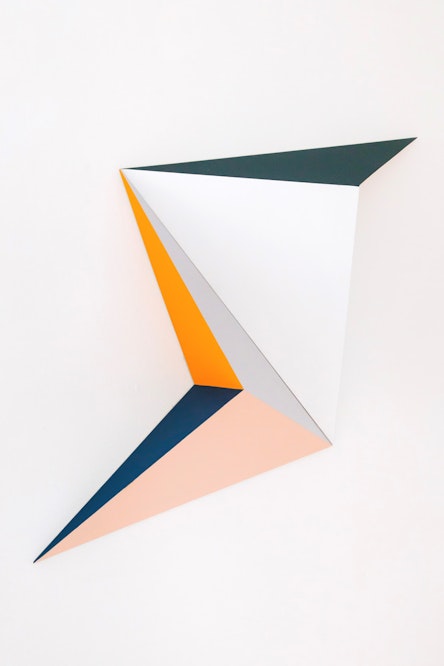
Juana does not create objects, she creates ingeniously through them, encouraging play, playfulness, or relaxation. Juana Gaviria is a Colombian-American artist who studied architecture and fine arts at the Rhode Island School of Design, RISD where she learned the value of a process, different techniques, and aesthetics. Her interest is in material, form, manual dexterity and the function of objects in space, paying homage to the basic principles of Bauhaus and the influence it has had on her career as an architect, designer, and artist. Through the use of different materials and techniques such as wood assemblages, reliefs, kite structures, mobiles, bent metals, tempered fabrics, and collages she elaborates on visual concepts that interest her such as asymmetry, balance, and equilibrium of color and form. His work can be described as having a certain movement and three-dimensionality through the juxtaposition of color planes that interact with each other to create geometric abstractions. Like Paul Klee, Sophie Tauber Arp, and Ray Eames, Juana understands that the grouping of certain colors is perfect. The artist invites you to interact with shapes, shadows, color, and space-creating compositions that have a strong visual strength but at the same time a meditative quality.